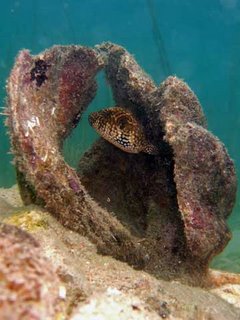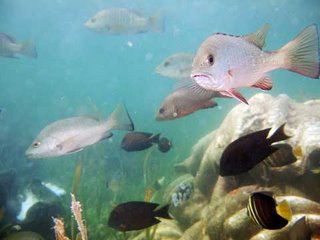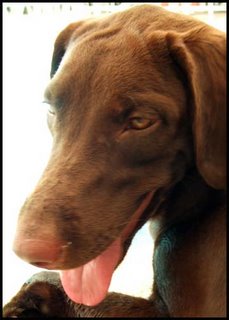
PISALAYAN Island, Bolinao, Pangasinan
March-April, 2006
We met Paul the Belgian at the Oarhouse, a little hole-in-the-wall in Malate. After a few rounds of isa pang one more ice-cold 'miglight, he graciously invited us to his hideaway in Pisalayan island off Bolinao, Pangasinan. He's been living there for several years now with his spirited wife Kelly along with their three dogs Ranger, Barangan, and Bunsoy.
What keeps Paul busy in his little pocket of paradise is the giant clam sanctuary he started some 10 years ago. About 25 metres from his beachfront and beneath 10 to 15 feet of sea live, at last count, over 2000 giant clams. Amidst a lush sea-grass garden, these clams serve as a reef for diverse fish to thrive. Schools of jack, anemone fish (more popularly called Nemo), angelfish, carp, butterfly fish, the elegant batfish, and many more have taken up residence in the ecosystem.
One man, ten years, 2000 clams, sustainable marine sanctuary. Imagine if another 10 people started doing the same thing in the area. NO DYNAMITE. NO CYANIDE. Sustainable fishing is possible.
We've been to his island twice now and had a great time snorkeling and freediving and laughing and bodypainting and eating and drinking and banging on bongoes like a chimpanzee. Thanks again to Paul and Kelly. See you guys soon for more Halo-Halo.
(How to make Halo-Halo (Paul's version): 3 parts Tanduay, 2 parts Tanduay, and 1 part Tanduay. Pour into tall Halo-Halo glass. Serve. Water on the side, optional

Ranger and Barangan chase off anyone that comes near the sanctuary.

Nicsaw, boatman, fisherman, Waray warrior from Samar, and friend.

A fisherman sells us his catch which included an octopus that Mehdi cooked to perfection.

Mehdi, Paul, Kelly, Derek and Gina strike a pose in front of the mangrove Paul started.

Portrait of puffer fish.

Snappers roam freely within the sanctuary.

These giant clams lie in a lush garden of sea grass.

A juvenile harlequin sweetlips takes shelter among the giant clams.


3 Comments:
Head: My Pisalayan experience
Subhead: Gina Abuyuan goes back to the basics to try to give a wee back to the sea
Photos by Regman Hernandez
We are told to conserve water. When we bathe, we are to use only a small pail, and use the tabo slowly. So slowly, our hostess jests, that we’d have enough time to imagine bathing with another. When we rinse, we are to step into a larger basin that will catch the old water, which will be collected and used for watering the plants.
We are on Pisalayan island in Bolinao, Pangasinan, with no electricity (save for the current supplied by solar panels), limited drinking water, and spare amenities. We plunge our plates into seawater after eating, segregate our garbage, sleep to the sound of silence. During the night, the darkness is broken only by the light of fireflies streaking across the black; during the day, the cycle of eating and sleeping is broken only by us checking out the seabed, where an astounding marine ecosystem lies.
My kind of rehab
It’s no ordinary vacation; we’re there on the invite of a Belgian friend (who prefers to keep his identity secret), who’s lived on the island since 1994. Coming back from his home country, where he and his Filipina wife Kelly (that I can reveal) lived a high profile life in the music business, he made a 180-degree turn and undertook what he calls “the Pisalayan Experience.”
“It started in 1994 after three years of observation of the seagrass-ecosystem inside the coral reef,” he says. “’Observations,’ because I had absolutely no know-how about the circle of life in the most important breeding places of the sea--the coral reef ecosystems.”
Currently, the coral reef ecosystem is one of the most endangered, due to water pollution, dynamite fishing, and cyanide fishing. To ensure a healthy coral reef, three other ecosystems have to be also present—beach, mangrove, and seagrass—to provide a balance for one another. When one is degraded, not only the balance of life is affected, but also the food source of many Filipinos (including, if you eat fish, you and me).
The purpose of the Pisalayan Experience, initially, my Belgian friend shares, was to “create a pocket of sea free of dynamite of cyanide fishing, where marine life would find a safe haven and bio-diversity would be maintained and improved.”
To set this up, he needed a place where the seagrass was healthy and close to the coastline. Pisalayan—which in the local dialect means “where turtles lay their eggs”—was perfect. (Three years after my friend mounted his project, the turtles, that had been lost for 20 years, did come back.)
The star of this ambitious rehabilitation was the baptismal font-shaped endangered Tridacna clams—otherwise known as the giant clams.
And they are what bring us to Pisalayan.
Low tech high
Twelve years and a wealth of experiences after (including being strong-armed by organizations about the irrelevance of his rehabilitation), our friend’s underwater sea garden has grown to cover a hectare. Demarcated by rope, rattan poles, and the occasional old slipper, his sea garden is a thriving marine ecosystem of two thousand giant clams and nearly 400 species of fish, anemone, and corals. There’s nothing fancy about it—everything is done at low technology, using recycled materials (like Kelly’s old socks as gloves when moving the shells), at almost no cost.
But some of the clams have gotten so huge and the garden so congested. Our friend needs help rearranging them, gathering up old shells from dead clams and building new houses for the fish. So we come—not so much to kick back and laze, but to reorganize the garden. Well, ok, I’m too small and weak to actually haul the shells up and out (they can weigh up to 500 kg), but I do my bit too: I help rearrange the coral, act as “marker” for the boys so they know where to pick up the shells, and scout for dead shells.
It’s tiring work, and work that needs a different kind of discipline: the discipline of an unhurried pace. We city folk are used to rush, rush, rushing to get things done. Our Belgian friend says this attitude could kill you when working with the clams. He’s seen people break their bones, get severe lacerations up their legs—serious injuries that called for an emergency banca to take them back to the mainland. “Take your time. If you feel tired, or are beginning to feel irritated, you stop. Rest. Go back. Go slow, go slow,” he cautions us.
And so we do. We walk through the water like we are in a slow-motion movie, take care not to let mistakes bother us, and are careful even with our laughter. We go slow. We tiptoe. We give back to the sea.
Paul
van harte dank voor jouw gastvrijheid!
Droomlocatie...
luc en ilona
Paul
van harte dank voor jouw gastvrijheid!
Droomlocatie...
luc en ilona
Post a Comment
<< Home